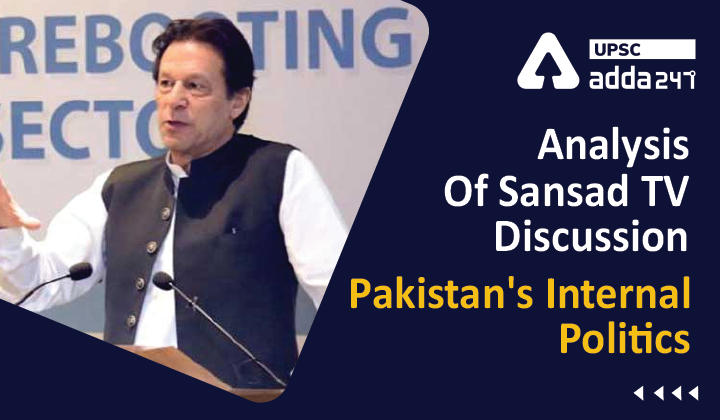Table of Contents
Analysis Of Sansad TV Discussion: ”Pakistan’s Internal Politics”
Relevance
”GS 2: Effect of Policies & Politics of Countries on India’s Interests”
Context
- Pakistan’s National Assembly Speaker, Asad Qaiser, on March 21 announced to convene the assembly session on March 25 to take up the no-trust motion against Prime Minister Imran Khan.
- Now, the lower house will deliberate on the Opposition’s no-confidence resolution against Prime Minister Khan on March 25. Once the motion is formally taken up by the house, the voting should be held between three to seven days.
Background
- Around 100 lawmakers from the Pakistan Muslim League-Nawaz (PML-N) and Pakistan Peoples Party (PPP) submitted the no-confidence motion before the National Assembly Secretariat on March 8.
- They allege that the Pakistan Tehreek-e-Insaaf (PTI) government led by Prime Minister Khan was responsible for the economic crisis and the spiralling inflation in the country.
- Last year(March 6, 2021) Khan had won a trust vote after he sought one after his party suffered an embarrassing defeat in the hotly-contested Senate elections.
Immediate Challenge for Imran Khan
- To successfully hold a crucial OIC meet for gaining public sentiment in his favour. The two-day event at the Parliament will have representatives of more than 50 countries in attendance.
- This is the 48th summit of the OIC-CFM will be held on March 22 and 23 under the theme: “Building Partnerships for Unity, Justice, and Development.”
About National Assembly of Pakistan
- Article 50 of the Constitution provides that the Parliament of Pakistan shall consist of President and the two Houses known as the National Assembly and the Senate.
- In the formation of the Cabinet the major portion (75%), goes to National Assembly while the rest (25%) are taken from the Senate.
The procedure of Removal of PM & President
Prime Minister
- A resolution for a vote of no-confidence is moved by not less than 20% of the total membership of the National Assembly.
- If the resolution is passed by a majority of the total membership of the National Assembly, the Prime Minister immediately relinquished powers.
President
- Similarly, for the removal or impeachment of the President, not less than one-half of the total membership of either House may give in writing its intention to do so, to the Speaker National Assembly, or, as the case may be, to the Chairman Senate, for moving a resolution for the purpose.
- In a joint sitting of the two Houses, convened for the purpose, and after the deliberations, if the resolution is passed by the votes of not less than two-thirds of the total membership of the Parliament, the President shall cease to hold office immediately on the passing of the resolution.
What do the figures say?
- Imran Khan is heading a coalition government and he can be removed if some of the partners decide to switch sides.
- In the 342-member National Assembly, the Opposition needs 172 votes to remove Khan.
- The PTI(Imran Khan’s Party) has 155 members in the House and needs at least 172 lawmakers on its side to remain in the government. The party has the support of 23 members belonging to at least six political parties.
- Nearly two dozen dissident lawmakers of the ruling party recently came out in the open ahead of voting on the no-confidence motion against Prime Minister Khan.
About OIC
- The Organisation of the Islamic Cooperation is the world’s second-largest multilateral body after the UN.
- The OIC is a 57-member grouping of Muslim majority nations, including Pakistan.
- The OIC’s stated objective is “to safeguard and protect the interests of the Muslim world in the spirit of promoting international peace and harmony among various people of the world”.
- The Central African Republic, Russia, Thailand, Bosnia & Herzegovina, and the unrecognised Turkish Cypriot “state”, have Observer status.
- The Organisation of the Islamic Conference was established by the First Islamic Summit Conference held in Morocco in September 1969, to marshal the Islamic world after an act of arson at the Al-Aqsa Mosque in Jerusalem by a 28-year-old Australian in 1969.
- It plunged the Middle East into its worst crisis after the 1967 Arab-Israeli war.



 TSPSC Group 1 Question Paper 2024, Downl...
TSPSC Group 1 Question Paper 2024, Downl...
 TSPSC Group 1 Answer key 2024 Out, Downl...
TSPSC Group 1 Answer key 2024 Out, Downl...
 UPSC Prelims 2024 Question Paper, Downlo...
UPSC Prelims 2024 Question Paper, Downlo...




